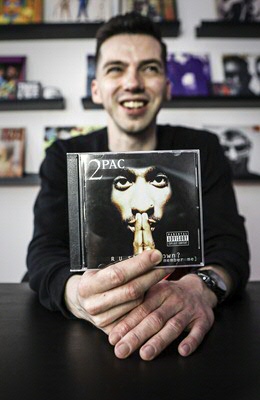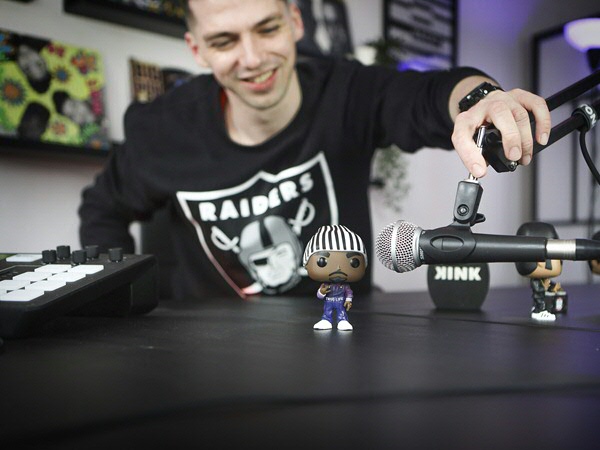How changing his accent made 2Pac a credible West Coast rapper

13 September marks the 25th anniversary of rapper 2Pac’s death, following an assassination attempt. 2Pac went down in history as the Che Guevara of hip hop. 13 September is also the date on which Steven Gilbers will be awarded his doctorate. His research topic, namely the way in which the famous rapper adjusted his speech to forge a new identity for himself, was initially met with scepticism. He had to work hard to convince others – including U.S. ambassador Pete Hoekstra – of the relevance of his research.
Text: Eelco Salverda, UG Communication Office/Photos: Henk Veenstra
Gilbers, who, as well as being a linguist, is also a rapper, was looking for an inspiring topic for his doctoral research. Wouldn’t it be great if he could combine his personal interests with linguistic research? The track Thug Style, in which 2Pac (stage name of Tupac Shakur) raps about belonging to neither the West Coast scene nor the East Coast scene, gave him an idea. In hip hop, language, culture and identity are always closely intertwined. For 2Pac, these connections were even more significant than for other rappers. Having grown up in New York, he moved to California when he was 17. For a rapper, this was a move as drastic and controversial as a top-ranking football player defecting to a rival team in another city. At the age of 24, by which time he had become a figurehead of the West Coast scene, he publicly antagonized the rap scene in New York and found himself being vilified by the very people he had grown up with. ‘Within hip hop, it matters hugely where you come from. You represent your neighbourhood, your city. So, I thought I would look at how 2Pac used speech as an expression of his new identity.’
His trademark: extended vowels
Gilbers soon realized that there was a wealth of source material available to him: hundreds of music recordings and interviews that were easy to sort into chronological order, which meant that he was able to trace the development of 2Pac’s speech in minute detail. ‘I discovered that after he moved, his vowels got longer, more like the vowels of other rappers on the West Coast. The change was gradual at first, but speeded up suddenly around 1995, when his vowels became much longer – longer, even, than those of the original West Coasters. This rapid surge coincided with his signing of a major contract with Death Row Records, the largest hip hop label in the west, at the time when his rivalry with the East Coast scene was at its height. He was clearly making a point by ensuring that he sounded more western than those originally from the West.’ Gilbers plays me two different fragments and it’s hard to believe that I’m listening to the same person in both. ‘2Pac absorbed and adopted each and every West Coast trait so thoroughly that he ended up sounding like a West Coast rapper on steroids.’

Hobby or work?
Gilbers is adding the finishing touches to his thesis in the Homebase studio at the Simplon pop music venue. Homebase is the flag under which Gilbers and Frank Stevens create podcasts and radio broadcasts about rap for the music channel KINK. It’s not often that there’s such synergy between someone’s research and their hobby. Posters, recording equipment, hip hop CDs: everything about Gilbers’ workspace breathes music. The white wall is lined with black shelves adorned with LPs by Public Enemy, A Tribe Called Quest, Nas and Big Pun. On the table are two sizable microphones, a mixing console and a tiny 2Pac figurine. Gilbers admits that combining his work and hobby like this can be distracting. ‘It’s difficult to keep the two separate. That was a bit of an issue when I was doing my research.’ I am interviewing Gilbers in his native Dutch tongue, but he has become so used to peppering his speech with American words and expressions that he sometimes has difficulty coming up with the right Dutch equivalent.
Creativity
Gilbers is the first person to have conducted linguistic research on rappers, so he sometimes found himself having to reinvent the wheel when it came to research design and data analysis methods. He compares his situation to the early days of hip hop. ‘At the start, there was no funding, nobody was interested, there just wasn’t a platform. So, the first rappers took their parents’ records and rapped over them. If the resources aren’t there, you have to get creative. But I like improvising,’ he says with a laugh, ‘that’s when I’m at my best. That piece of equipment over there is a Maschine MIDI controller. It’s basically a music-making machine. I came up with the idea of using it to do statistical analyses of the rap flows of 2Pac and other rappers.’
The Che Guevara of hip hop
You can be pretty sure that 2Pac would never have dreamed that one day, a miniature plastic likeness of himself would end up in an obscure little European country on the desk of a researcher who had decided to study his pronunciation! The figurine reflects the context of Gilbers’ research. 2Pac became a larger-than-life figure, the Che Guevara of hip hop. The formerly negatively portrayed hip hop has become more mainstream and is now even the object of academic research. Gilbers calls 2Pac the most iconic rap artist of all time. But what do today’s teenagers and young adults know of him? ‘2Pac influenced many other rappers and set the standard for what constitutes good hip hop. But to my mind, his most important contribution is what he did for the image of rappers. Sadly, that was partly thanks to his violent death, which afforded him legendary status.’ What would 2Pac have thought of Gilbers’ research? ‘I hope he would say “It’s an honest analysis of me and of my work. Pretty dope!”’

Outsider
Having completed his detailed analysis of 2Pac, Gilbers turned his attention to the more general differences in melody and rhythm between rappers in the East and the West of the U.S.. So, what did the Black rap scene in the U.S. make of his research activities? Didn’t they think it was odd that a white European scholar would presume to have something to say about what they sounded like? ‘Well yes, that’s pretty much how it was. They were intrigued, and surprised that an academic would show an interest in them. But there was definitely scepticism too: is this guy genuine or is he just another cultural peeping tom? Once, I was giving a lecture and there was a man in the audience leaning back in his chair, looking distrustful. At one point, he shouted out a few words. I recognized them as a quote from a rap by De la Soul, Stakes is High and responded appropriately. He suddenly sat up and started paying attention. Later, I realized that he’d been testing me. He’d wanted to see whether I really knew my hip hop.’
More recognition for the genre
In a way, Gilbers has become a sort of mouthpiece for hip hop, opening the door to a new world. He believes that it is high time that hip hop artists received more recognition. ‘Some hip hop artists know more about rhyme than we academics do. In the early days, people dismissed rap as a fad, calling it unmelodious and referring to it as “non-music”. But here we are, fifty years later, and it’s still going strong. In fact, it's one of the most influential musical expressions in the world! And people dare to suggest that we shouldn’t take it seriously, just because it’s at odds with our western musical criteria? That’s just plain nasty. If my research leads to rap being given the recognition it deserves, then I would be very happy.’
American ambassador
Gilbers tells an anecdote that reinforces his message beautifully. In 2017, he was awarded an American Fulbright scholarship to do research in the U.S.. Presenting the award was none other than U.S. Ambassador to the Netherlands, Pete Hoekstra. ‘“Hip hop? We’re funding hip hop research now?!”, Hoekstra scoffed when we met. I fixed a smile on my face and replied cordially, “Yes sir, it’s your number one cultural export product”’.
More information
| Last modified: | 29 August 2022 09.58 a.m. |
More news
-
03 May 2024
NWO Impact Explorer for Suzanne Manizza-Roszak's impactful postcolonial literary research
Suzanne Manizza-Roszak, Assietent Professor English at the Faculty of Arts has received an Impact Explorer grant from the Dutch Research Council (NWO) for her postcolonial literary research and the project to translate the results into social...
-
29 April 2024
Learning to communicate in the operating theatre
The aios operates, the surgeon has the role of supervisor. Three cameras record what happens, aiming to unravel the mechanisms of 'workplace learning'.
-
23 April 2024
Studying depopulation also means studying the history of those who stay
Assistant professor Yuliya Hilevych from the Faculty of Arts researches regional depopulation in the Netherlands, Finland, and Ukraine by placing the phenomenon in a social-historical perspective.
